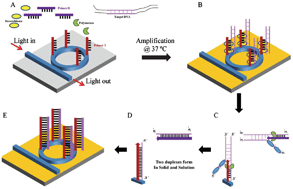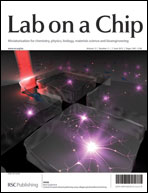Real-time, label-free isothermal solid-phase amplification/detection (ISAD) device for rapid detection of genetic alteration in cancers
Abstract
Here, we first present an isothermal solid-phase amplification/detection (ISAD) technique for the detection of single-point mutations that can be performed without labelling in real-time by utilizing both silicon microring-based solid-phase amplification and isothermal recombinase polymerase amplification (RPA). The ISAD technique was performed on a silicon microring device with a plastic chamber containing 10 μL of the reaction mixture, and characterized with an assay for the detection of the HRAS (Harvey RAS) gene single-point mutation. For the solid-phase amplification, the primer of the gene was directly attached to the surface of the device via an amine modification reaction. The amplified DNA was detected, without a label, by measuring the optical wavelength shift of the silicon microring resonator during the reaction. We demonstrated that the sensitivity of the ISAD technique was 100-times higher than that of RPA and conventional PCR methods. Moreover, this technique can be used to distinguish a single-point mutation of the HRAS gene via target amplification. This novel DNA amplification/detection technique will be useful for the detection of sequence alterations such as mutations and single-nucleotide polymorphisms as DNA biomarkers in human diseases.


 Please wait while we load your content...
Please wait while we load your content...